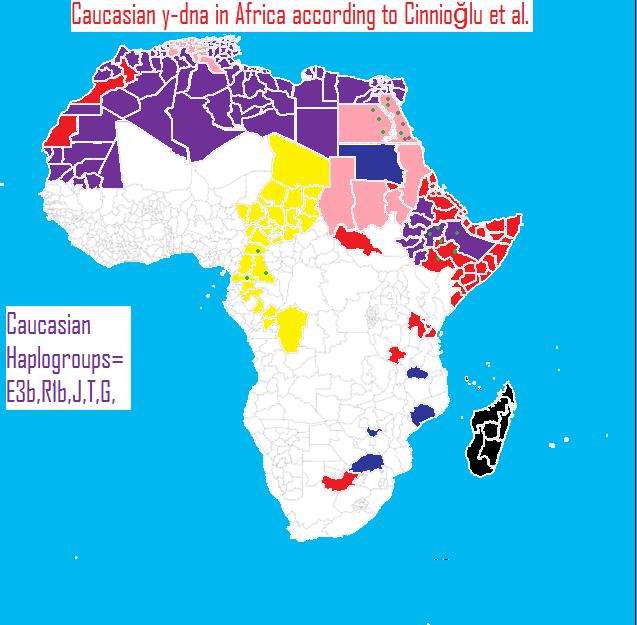Foreign interactions with Europe
This article deals with the history and evolution of Sub-Saharans and Eastern Eurasians in Europe.
DNA
Y-DNA
In Europe, African Y-DNA chromosomes (which are defined as A, B and sub-Saharan variants of the Eurasian E) are consistently found at frequencies of less than 1% (with the exception of Portugal which may have up to 3% African Y-DNA).[1] It is a somewhat controversial issue over what an African Y-DNA haplogroup is, because some Eurasian haplogroups such as haplogroup J, E3b, and even haplogroup R (particularly R1B) are often incorrectly labeled as being African because they can be consistently found at a high frequency in the Afro-Asiatic speakers that live in Africa.[2][3] Genetic studies disprove this for example Haplogroup E3B has been proven by science to have begun in the Near East.[4]
Mtdna
African mtDNA (Haplogroup L which is genetically isolated) is rare in Europe although much more common then African Y-DNA.[5] It is most common in Portugal where 5% of people have it, though outside of Portugal it quite rare (consistently lower than 1%). For example, its frequencies run at 0.7% in Finland, 0.4% in Spain, and 0.1% in Ireland.[6][7] As in Y-DNA many Caucasian mtDNA haplogroups (such as U6 and H1) and also some Eurasian mtDNA haplogroups such as (M1) are often wrongly described as African; probably because they can be found at high frequencies in the Afro-Eurasian speakers who also have a high consistency of Caucasian Y-DNA haplogroups.[8]
History
Early history
The early history of Eastern Eurasian and African interactions with Europe can be found by the genetics of contemporary European populations. Both populations seem to have had little influence on Europe In fact less than 1% of Europeans (including Spaniards) have African y-dna or mtDNA [9] [10] [11]
Eastern Eurasian dna is much more common and is represented mostly by the presence of haplogroup N3 in far north east Europe.[12] [12] Interestingly many African populations have a large proportion of western Eurasian DNA particularly north Africa which is about 90% western Eurasian [13] the above study is confirmed by y-dna and mtDNA analysis of north Africa for example over 90% of north African men belong to the western Eurasian E3B,J,G, or R1 haplogroups [9] In sub-Saharan Africa amounts of western Eurasian DNA can be found in speakers of the afro-Asiatic language branch.
African populations in Europe
In modern Europe up to 1% of the population is African (excluding north African) in origin.
Eastern Eurasian populations in Europe
In modern Europe up to 1% of the population is eastern Eurasian in origin.
Images

References
- ↑ https://scholar.google.com/scholar?hl=en&lr=&cluster=11056732165607900434&um=1&ie=UTF-8&ei=F7DvSoyoMommNp2jwIoH&sa=X&oi=science_links&resnum=1&ct=sl-allversions&ved=0CAoQ0AIwAA
- ↑ http://www.jogg.info/11/coffman.pdf
- ↑ http://hpgl.stanford.edu/publications/AJHG_2002_v70_p1197-1214.pdf
- ↑ https://genographic.nationalgeographic.com/genographic/lan/en/atlas.html
- ↑ http://www.promega.com/Catalog/CountrySelect.aspx?returnurl=/geneticidproc/ussymp6proc/antti.htm
- ↑ Rhouda et al
- ↑ "Mitochondrial DNA variation of modern Tuscans supports the near eastern origin of Etruscans". Am. J. Hum. Genet. 80 (4): 759–68. April 2007. doi:10.1086/512822. PMC 1852723
 . PMID 17357081.
. PMID 17357081. - ↑ "Mitochondrial lineage M1 traces an early human backflow to Africa". BMC Genomics. 8: 223. 2007. doi:10.1186/1471-2164-8-223. PMC 1945034
 . PMID 17620140.
. PMID 17620140. - 1 2 Y-Chromosomal Diversity in Europe Is Clinal and Influenced Primarily by Geography, Rather than by Language
- ↑ Determination genétique de l’individu Néolithique de Segudet (Ordino), les restes humains les plus anciens d’Andorre
- ↑ Geographic Patterns of mtDNA Diversity in Europe
- 1 2 http://www.nature.com/ejhg/journal/v15/n2/abs/5201748a.html
- ↑ Worldwide human relationships inferred from genome-wide patterns of variation